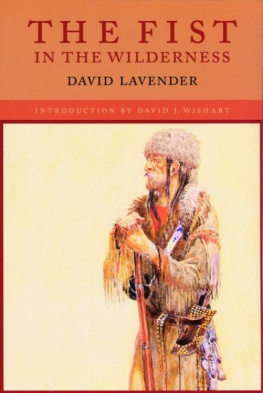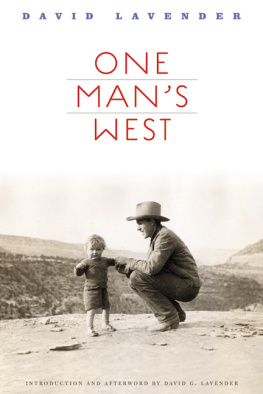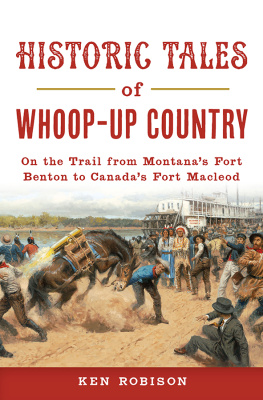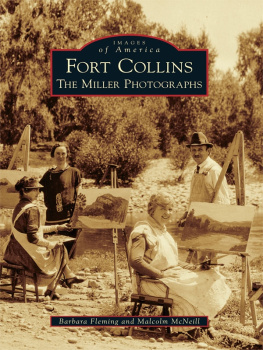David Lavender - Bents Fort
Here you can read online David Lavender - Bents Fort full text of the book (entire story) in english for free. Download pdf and epub, get meaning, cover and reviews about this ebook. year: 2013, publisher: Bison Books, genre: Detective and thriller. Description of the work, (preface) as well as reviews are available. Best literature library LitArk.com created for fans of good reading and offers a wide selection of genres:
Romance novel
Science fiction
Adventure
Detective
Science
History
Home and family
Prose
Art
Politics
Computer
Non-fiction
Religion
Business
Children
Humor
Choose a favorite category and find really read worthwhile books. Enjoy immersion in the world of imagination, feel the emotions of the characters or learn something new for yourself, make an fascinating discovery.
- Book:Bents Fort
- Author:
- Publisher:Bison Books
- Genre:
- Year:2013
- Rating:5 / 5
- Favourites:Add to favourites
- Your mark:
- 100
- 1
- 2
- 3
- 4
- 5
Bents Fort: summary, description and annotation
We offer to read an annotation, description, summary or preface (depends on what the author of the book "Bents Fort" wrote himself). If you haven't found the necessary information about the book — write in the comments, we will try to find it.
Bents Fort was a landmark of the American frontier, a huge private fort on the upper Arkansas River in present southeastern Colorado. Established by the adventurers Charles and William Bent, it stood until 1849 as the center of the Indian trade of the central plains. David Lavenders chronicle of these men and their part in the opening of the West has been conceded a place beside the works of Parkman and Prescott.
Bents Fort — read online for free the complete book (whole text) full work
Below is the text of the book, divided by pages. System saving the place of the last page read, allows you to conveniently read the book "Bents Fort" online for free, without having to search again every time where you left off. Put a bookmark, and you can go to the page where you finished reading at any time.
Font size:
Interval:
Bookmark:

Bents Fort
David Lavender
University of Nebraska Press Lincoln/London
Copyright, 1954, by David Lavender
All rights reserved
International Standard Book Number 978-0-8032-5753-5
Library of Congress Catalog Card Number 54-7322
Bison Book edition reproduced from the Dolphin Book edition by arrangement with Doubleday & Company, Inc.
FOR
M.M.L.

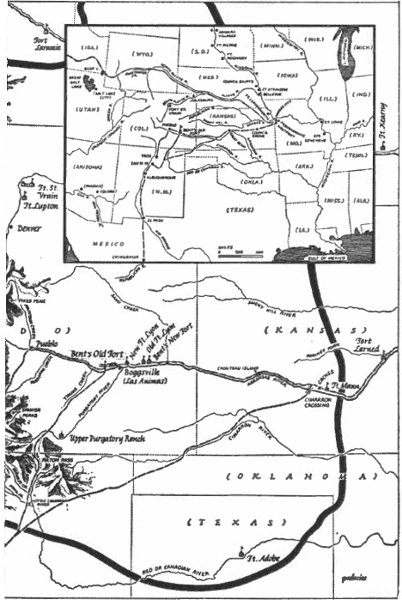
Contents
Introduction
The Place Called Purgatory
Northeast from the Spanish Peaks of Colorado a small creek flows toward the Arkansas River. Some miles from its mouth its canyon walls drop off into rich bottomlands where in olden days gnarled cottonwoods shaded the thick grass and reeds. Wild turkeys foraged in thickets of plum and grape, deer browsed among the sunflowers, and in the autumn huge bears snuffed at the chokecherries. To red men and white this spot of green was a welcome oasis in the sun-scorched plains of what is now southeastern Colorado. Yet the name by which three nations of whites called it was gloomy: El Rio de Las Animas Perdidas en PurgatorioThe River of Lost Souls in Purgatory.
The myth (or fact, if you will) that created the name is older than the landing of the Pilgrims on Plymouth Rock. In 1594 or thereabouts, even before the founding of Santa Fe, an expedition was sent out of Mexico, so the story says, to suppress the Indians beyond the border. Its leaders, Leiva Bonilla and Juan de Humaa, knew that Coronado fifty years before had gone in this direction, fruitlessly searching for fabled Quivara; and when their mission against the savages was completed, Bonilla and Humaa likewise began to dream of the unknown.
News of their intentions leaked back to Mexico, and the governor sent orders for them to return. Only six men obeyed, the remainder continuing with their truant captains. Soon the leaders quarreled and Bonilla was slain. Convinced by this that the illegal trip was accursed, the expeditions priests forsook it. Defiantly Humaa pushed ahead without them.
If arrogance admits of justification, these men had it. Spains early entradas into the New World drew the cream of the nation. To them the endless plains were not the shock they were to later Anglo-Saxons; for Spain, too, was semi-arid and almost timberless, and Spanish horses, bred from Arabian stock, were well fitted for crossing southwestern Americas sun-blasted, wind-swept land. The Indians whom the adventurers met were mere foot creatures, beneath contempt as opponents.
On this occasion, however, the self-assured Spaniards grew careless. One dawn, while the camp slept, the miserable, unmounted, unchivalrous savages set fire to the tall grass. In a confusion of smoky flame, while stampeding horses neighed shrilly and panicked men called back and forth, every person perished save only a mulatto girl and a man named Alfonso Sanchez, who, so the tale runs, later became a great chief among the killers of his companions.
Years passed, Santa Fe was founded, and a roaming party of explorers discovered near a small stream flowing from the Spanish Peaks the rusted arms of what had once been a large force. Only this remained of disobedient men who had died abandoned by their own priests. In awe the discoverers named the purling creek El Rio de Las Animas Perdidas en Purgatorio.
The name clung. More than a century later, as French traders groped west and south from the Missouri, they found the creek and shortened its resounding title to the single word Purgatoire. Still later the Americans met it; some clipped the Spanish down to Las Animas; others, wrestling the French consonants, corrupted Purgatoire into Picketwire. Call it what you wish. El Rio de Las Animas Perdidas en Purgatorio, Las Animas, Purgatoire, Picketwire, or just plain Purgatoryit has heard them all.
And it has watched nearly every major event in the winning of the Southwest.
Pike forded it as his ill-equipped expedition marched westward to explore the lower reaches of Jeffersons Louisiana Purchase. Near its banks his men first glimpsed the dim blue bulk of the Rockies and with one accord raised three cheers for the Mexican mountains. It was a cheer that Spanish officials did not return. With diplomatic finesse Pike was arrested and hustled out of the country. No finesse whatsoever greeted later intruders. Several stayed in prison for as long as nine years, and in 1817 De Mun, Chouteau, and their St. Louis trappers suffered confiscation of thirty thousand dollars worth of furs.
During the course of rounding up the De Mun-Chouteau party, two hundred Mexican soldiers marched across the Raton Mountains toward the Arkansas. They were brave men if they believed their own story, for it was said that twenty thousand American troops were stationed in a strong fortification near El Rio de Las Animas Perdidas.
No fort was therein 1817. But sixteen years later one came into being, conceived not by the military but by two St. Louis brothers, Charles and William Bent, recently displaced from the Missouri River by the violent trade wars to control its commerce. Here on the borders of a foreign land they found a field for a fresh start. Together with Ceran St. Vrain, a man who knew the Mexicans well, they built a vast mud castle that Mexico came to fear far more than she had its mythical predecessor. There was reason. For here was the spearhead of American expansion to the Southwest.
Call the roll of the pathbreakersCarson, Beckwourth, Old Bill Williams, Maxwell, Walker, Wootton, Fitzpatrick of the broken hand, Frmont, and a forgotten host of others. Bent and St. Vrain gave them work or shelter as they opened the Southwest. Once the way was prepared, New Mexico, Arizona, and California were inevitably lost, not to twenty thousand American troops, but in large measure to seventeen hundred ragged soldiers of Stephen Watts Kearnys Army of the West marching out from their rendezvous at Bents Fort.
In that quick and almost bloodless conquest (not completely bloodless: Charles Bent died horribly in Taos) the frontier leapfrogged past this fort which so long had stood in advance of the frontier. A whole way of life vanished, and the agonies of readjustment began. Bewildered and bereft, William Bent violently obliterated the post with his own hands, turned down the Arkansas a few miles east of the Purgatory, and there built another huge fort.
One sees in that rebuilding an unconscious effort to hold onto the singing past of a mans youth, of a nations youth. The effort failed. Seven years passed, and again William Bent left his fort, returning to the mouth of the Purgatory just as the Colorado gold rush began sweeping across the plains. There he built a stockaded ranch on ground where thirty years before, in another stockade of cottonwood pickets, he had first entered into alliance with the Cheyenne Indians, who were to become more nearly his own people than were the Missourians among whom he had been born.
Purgatoryso indeed it must have seemed during the 60s, when the Plains Indians rose against extinction and Williams own sons, children of a red mother, joined her tribe to fight the white race of their father. Fight? It is too toneless a word for Chivingtons guns pouring into the defenseless camp at Sand Creek; for young Charles Bent, named after Williams beloved brother, lashing back at the whites with a savagery that led his father to disown him. Purgatorythere, in 1869, with most of the friends of the past already gone and the Cheyennes thrust from him onto a reservation, William Bent died.
Next pageFont size:
Interval:
Bookmark:
Similar books «Bents Fort»
Look at similar books to Bents Fort. We have selected literature similar in name and meaning in the hope of providing readers with more options to find new, interesting, not yet read works.
Discussion, reviews of the book Bents Fort and just readers' own opinions. Leave your comments, write what you think about the work, its meaning or the main characters. Specify what exactly you liked and what you didn't like, and why you think so.




